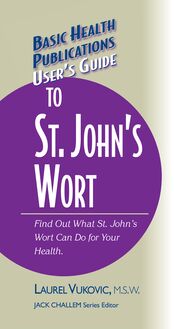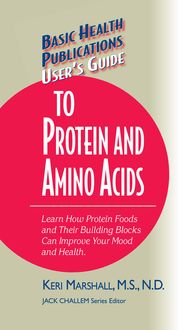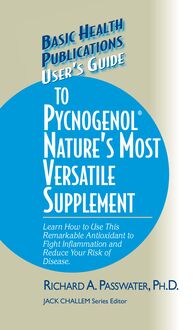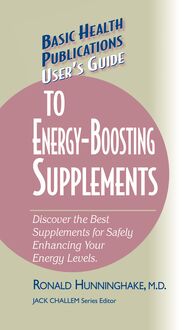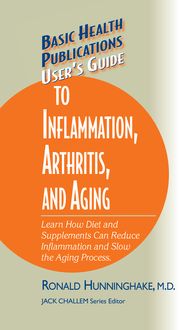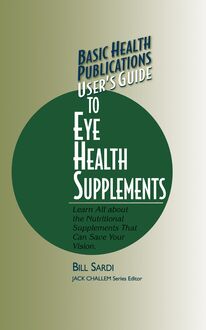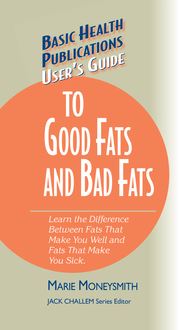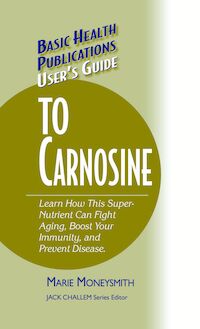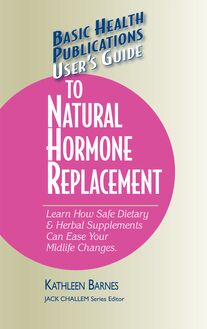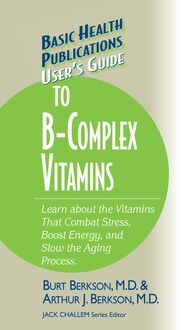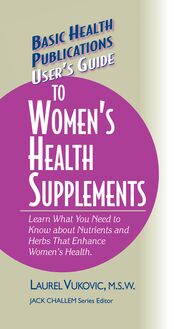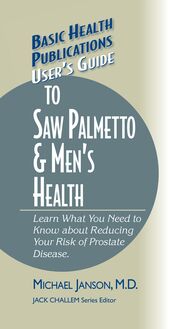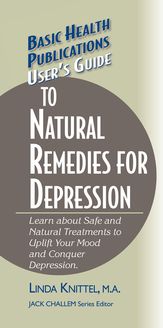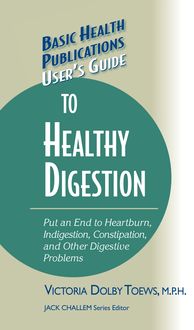User's Guide to Propolis, Royal Jelly, Honey, and Bee Pollen , livre ebook
45
pages
English
Ebooks
2005
Vous pourrez modifier la taille du texte de cet ouvrage
Obtenez un accès à la bibliothèque pour le consulter en ligne En savoir plus
Découvre YouScribe en t'inscrivant gratuitement
Découvre YouScribe en t'inscrivant gratuitement
45
pages
English
Ebooks
2005
Vous pourrez modifier la taille du texte de cet ouvrage
Obtenez un accès à la bibliothèque pour le consulter en ligne En savoir plus
Publié par
Date de parution
15 juillet 2005
Nombre de lectures
1
EAN13
9781591206903
Langue
English
Poids de l'ouvrage
1 Mo
Publié par
Date de parution
15 juillet 2005
Nombre de lectures
1
EAN13
9781591206903
Langue
English
Poids de l'ouvrage
1 Mo
The information contained in this book is based upon the research and personal and professional experiences of the author. It is not intended as a substitute for consulting with your physician or other healthcare provider. Any attempt to diagnose and treat an illness should be done under the direction of a healthcare professional.
The publisher does not advocate the use of any particular healthcare protocol but believes the information in this book should be available to the public. The publisher and author are not responsible for any adverse effects or consequences resulting from the use of the suggestions, preparations, or procedures discussed in this book. Should the reader have any questions concerning the appropriateness of any procedures or preparations mentioned, the author and the publisher strongly suggest consulting a professional healthcare advisor.
Series Editor: Jack Challem
Editor: Cheryl Hirsch
Typesetter: Gary A. Rosenberg
Series Cover Designer: Mike Stromberg
Basic Health Publications User’s Guides are
published by Basic Health Publications, Inc.
28812 Top of the World Drive
Laguna Beach, CA 92651
949-715-7327 • www.basichealthpub.com
Copyright © 2005 C. Leigh Broadhurst, Ph.D.
ISBN: 978-1-59120-690-3
All rights reserved. No part of this publication may be reproduced, stored in a retrieval system, or transmitted, in any form or by any means, electronic, mechanical, photocopying, recording, or otherwise, without the prior written consent of the copyright owner.
Printed in the United States of America
10 9 8 7 6 5 4 3 2
C ONTENTS
Introduction
1. Honey—Sweet Protection against Infection
2. Propolis—An Antioxidant Powerhouse
3. Bee Pollen—Nothing to Sneeze At
4. Royal Jelly—Nutrients Fit for Royalty
Conclusion
Selected References
Other Books and Resources
I NTRODUCTION
T he honeybee ( Apis mellifera ) is the world’s most popular insect. Native to Europe, it has been introduced successfully in every continent except Antarctica. Bees thrive from Russia and Scandinavia through the Tropics and “down under” in Australia and New Zealand. The immense value of honeybees to the world is not commonly appreciated.
According to the U. S. Department of Agriculture, one mouthful in three of the foods you eat directly or indirectly depends on pollination by honeybees. Honeybee pollination is worth 14 billion dollars annually to the agriculture industry.
Apiculture is the formal name for commercial bee keeping. Apiculture was practiced in ancient Egypt, Mesopotamia, Greece, Rome, India, and China. Ancient Buddhist, Christian, Hindu, Moslem, and Native American cultures revered the honeybee, as do their modern counterparts. China has a 3,000-year continuous tradition of apiculture. In the 1600s, workers in Shenyang collected 2,500 to 3,000 kilograms of honey each year just to supply the Emperor’s Palace.
Did you know that throughout history apiculture has been just as important for providing medicine as it has food? Beekeepers were usually among the longest-lived individuals in a town or village, due to their prodigious consumption and use of beehive products.
These valuable beehive products are honey, propolis, bee pollen, and royal jelly. In this book the many natural health uses of apiculture are brought up to date and scientifically documented. Let me give you an idea of how you and your family can benefit from these amazing substances: Honey is the world’s best-known treatment for burns, infected wounds, and skin ulcers. It can kill wound bacteria that are resistant to anti biotic drugs. Using honey as a sweetener in stead of sugar adds antioxidant protection to your diet. Taking propolis daily can reduce both the number of respiratory infections you contract during the winter season and their severity. Propolis salve is a highly effective treatment for herpes. It is also one of the most effective herbal detoxifiers and antioxidants known, and as such can benefit people with chronic diseases from arthritis to cancer. A teaspoon of bee pollen provides you with a quick and easy way to eat the equivalent of one large serving of vegetables. Bee pollen is an effective treatment for hay fever, prostatitis, and varicose veins. Taking royal jelly daily can reduce your risk for cardiovascular disease and strengthen your immunity. It’s also a superior cosmetic ingredient for moisturizing and smoothing facial wrinkles.
Honey, propolis, bee pollen, and royal jelly each have their own chapter in this book that’s more or less self-contained. However, it’s important that you at least skim Chapter 1 first because many important terms are defined there that will be used throughout the book. This also makes Chapter 1 the most demanding to read in the book, but worth investing your time and attention.
Each chapter includes details from research studies that explain how bee products work medicinally. These sections are more scientific than others in the chapter and you do not need to read them to use this book.
Please take the time to understand this fascinating and truly helpful information about beehive products. The natural health uses of honey, propolis, bee pollen, and royal jelly are so diverse that any household can find something that applies. After you’ve read this book, I guarantee you will appreciate the honeybee as never before!
CHAPTER 1
H ONEY —S WEET P ROTECTION AGAINST I NFECTION
H oney is made from flower nectar that is collected by worker honeybees in spring, summer, and early autumn. Some worker bees also collect “honeydew” from the sugary secretions of aphids that feed on tree sap. The nectar is greatly concentrated and is stored in wax cells, thousands of which form the honeycomb. In a natural honeybee colony, honey serves as food for the bees through the winter when plants are dormant. In an apiculture hive, where most of the honeycomb is removed to extract the honey and beeswax, the beekeeper provides the bees with sugar or a corn-syrup solution to sustain them.
Beekeepers earn most of their income by renting their bee colonies to farmers and orchardists. The hives are transported to the places where important crops are in bloom, and the bees “work for food,” gathering nectar and pollen while pollinating the crops. Pollinating California’s almond trees alone takes about 1 million bee colonies. Honey is the tasty result of all this pollination effort.
The Composition of Honey
For millennia, honey has been appreciated for its delicious sweet flavor and digestibility. Honey is 15 to 21 percent water by weight, and almost all of the remainder is carbohydrate. About 85 percent of the solids in honey are the simple sugars glucose and fructose. There are minor amounts of sucrose, maltose, and other sugars—the exact composition varies with the honey.
The sugar molecules in honey are strongly attracted to the water and bond to it. This is one reason why honey is a viscous syrup instead of a crystalline solid like table sugar (pure sucrose). If an attempt is made to dry out honey, it will rapidly reabsorb water from the atmosphere and return to its liquid state.
Honey does crystallize sometimes. Crystallization can happen spontaneously in a jar that has been on the shelf for a while, or honey can be purposely crystallized by the manufacturer to make spreadable honey products. However, crystalline honey is still sticky and contains lots of water; it is not dry and spoonable like pure sucrose crystals.
A few percent of honey consists of phytochemicals from the various nectar source plants. These phytochemicals cause endless variation among honeys, similar to the effects of adding various herbs, spices, or extracts to plain bread. Unprocessed or lightly processed honey always retains the flavor and aroma of the nectar source plants, and this is what really makes it special.
Phytochemicals Natural, biologically active chemicals made by plants, such as lycopene in tomatoes and watermelon, quercetin in tea and onions, anthocyanins in grapes and bilberry, and menthol in spearmint and pennyroyal.
Raw, unprocessed honey is like fine wine—the source plants, growing location, season, climate, weather, processing, and just plain luck influence the color, aroma, and flavor. Commercial beehives may be placed in orange groves to produce fragrant orange-scented honey, or in white clover fields to produce light, mild, all-purpose clover honey. Buckwheat flowers produce strong, dark, musky honey that’s an excellent substitute for molasses in baking or barbecue sauce. However, buckwheat honey like buckwheat pancakes is definitely an acquired taste for the gourmet palate!
Honey Is an Herbal Tonic
When the word “phytochemical” is used in the fields of nutrition and natural healing, it refers to the phytochemicals that people eat and use medicinally. These phytochemicals have measurable health effects on our metabolism. The various phytochemicals in honey not only influence taste and aroma, but they also provide antioxidant protection, healing properties, and nutritional benefits.
Luckily for us apicultural scientists are interested in identifying the phytochemical composition of honey for several reasons. Most important, the trace phytochemicals in honey provide scientists with a “fingerprint” that can be used to identify the source plants visited by the bees. The phytochemicals in honey can be extracted and then compared to phytochemical extracts from likely source plants near the hives where the honey originated.
In a given foraging area, there are potentially many source plants sampled in any type of honey produced. But in practice, bees visit favorite plants again and again, presumably because these plants provide more abundant and nutritious nectar and pollen.
Identifying preferred source plants is also important so that beekeepers know where to locate hives and what plants to grow to help keep bees healthy and productive. There are also some sour
